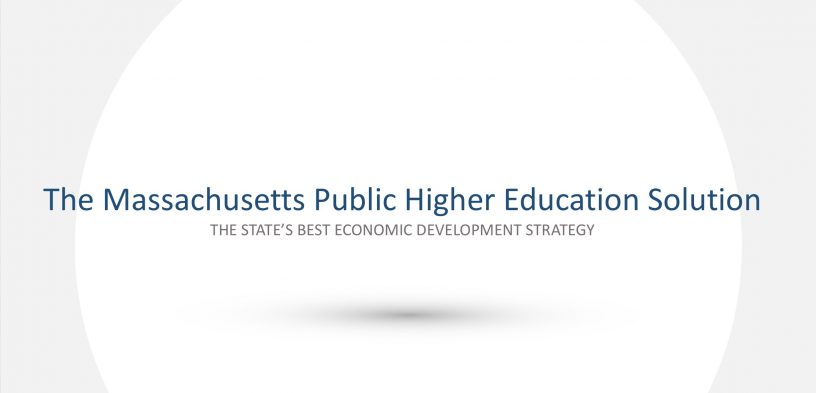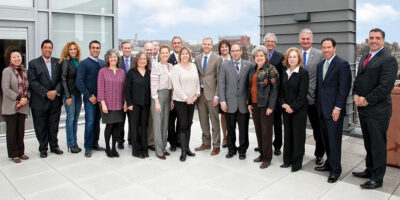In addition to being a college president and spending my days (and frequently my nights) thinking about student enrollment and success, academic programs, fundraising, workforce development, and a host of other pressing issues; I’m also a dad with a daughter heading off to college herself in the fall.
Like parents and college students everywhere, we’ve been exploring and weighing options: Close to home or far away? Big or small? Urban, suburban, or rural? Public or private? And so on.
And, also like parents and college students everywhere, we see the headlines and hear the concerns about the rising costs of attending college, increasing student loan debt, low graduation rates, and the big one: return on investment (Is a college degree still worth it?)
Well, the short answer to that last one is a resounding YES, especially in Massachusetts, where for most people it is a requirement for any job that is going to pay a livable wage, offer benefits, and the opportunity for a lengthy career.
But what about all those other questions, especially that choice between public and private institutions? And how do community colleges fit in?
Well, it’s budget season in the Bay State, and the presidents of Massachusetts’ public colleges and universities have created The Massachusetts Public Higher Education Solution, a presentation explaining the costs and benefits of attending, and supporting, public higher ed that we are sharing with elected officials, policymakers, and others.
Wait, don’t go away!
This won’t take long, and I think you’ll find a lot of information that may be surprising, certainly encouraging, and can help you make some decisions yourself about college, if you are one of those families with some choices ahead.
You may also be inspired to step up and speak out in support of public higher education (and particularly community colleges) in Massachusetts.
You can view the entire presentation below, and if you’re a fan of Cliff’s Notes, here’s a quick plot summary:
- Community colleges enroll the largest number of students among the three segments of higher education in Massachusetts, and account for over 40% of total undergraduate enrollment.
- While the total annual number of graduates from community colleges has slightly declined, due to decreased enrollments, we are still “punching above our weight,” and produce more than a third of all higher education credentials in the Commonwealth each year.
- Graduation rates at Massachusetts community colleges, state universities and UMass campuses significantly exceed national averages.
- In Massachusetts, education pays: Associate degree holders earn 28% more than those with only a high school diploma, and salaries for bachelor’s degree holders are boosted a whopping 67%.
- Those with college degrees pay considerably more in lifetime taxes than those with a high school diploma while receiving much less in government benefits.
- Overall, public higher education graduates are much more likely to stay and contribute to the Massachusetts economy. (Eighty-five percent of community college graduates live, work, buy homes, raise families, and pursue their careers near where they completed their education.)
- Massachusetts faces an acute shortage of workers with college degrees: As a result of Baby Boom retirements and a projected decline in the state’s population of high school graduates, there will be nearly 46,000 fewer adults ages 25-64 in Massachusetts with a college degree in 2030 than in 2020.
- Adult learners are an untapped resource: Only 6.5% of Massachusetts adults with a high school diploma (but not a bachelor’s degree) are enrolled in college.
- The solution to our economic challenges is improving the educational attainment of underrepresented groups.
- As the Massachusetts Department of Higher Education’s 2014 Degrees of Urgency report noted, “If African-American and Latino/a adults possessed college degrees at the same rate as white adults (60%), the state would easily meet its need for more college graduates by 2025.”
- The public higher education system, especially the state’s community colleges, is doing the most to educate underrepresented groups in Massachusetts. Seventy-two percent of African American and 79% of Latino/a undergraduates earn their degrees at public institutions.
- And across the three segments of higher education, community colleges enroll the largest proportion of first generation, low-income, minority students.
- Northern Essex Community College was New England’s first federally designated Hispanic Serving Institution. Over 40% of our students are Hispanic, over half are first-generation college students, and two-thirds are considered low-income.
- At the same time, Massachusetts is disinvesting in the public higher education system, and has cut per-student funding by 31% since 2001.
- We lag behind most other states in per-student spending, scholarships, need-based aid, and capital investment in higher education.
In short, the state’s public colleges and universities are already doing much more, for much less, to educate the citizens of Massachusetts; but we are at a critical crossroads, where we must decide if we are going to make necessary investments in the future of public higher education in order to maintain the prosperity the Commonwealth enjoys—and share it with everyone.






























